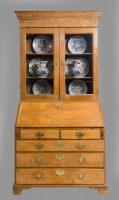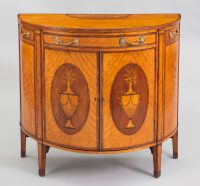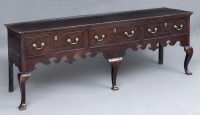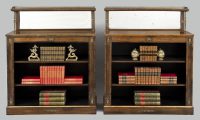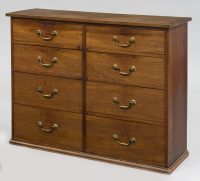Cabinets & Cupboards View All Case Pieces
Storage. Storage. Storage. Who doesn’t need more of it? An antique cabinet or cupboard is not only practical and functional but it adds a beautiful and distinctive atmosphere or ambiance to your home.
In the medieval era, very simple chests were made to store valuable items such as clothing, linens or marriage mementos. It served not only as a chest, but as a trunk, a seat, a table and a desk; quite versatile. Very simple, very practical. They would have been made from six planks of oak, pine, walnut or another local wood and nailed together or perhaps joined with a crude dovetail. For decoration they might have had ornate wood carvings.
In the 16th century, cabinets on stands were fashionable and were used for the storage of papers and small valuables. They were produced in Italy, Germany and Spain. They were decorated with rich oyster veneer and marquetry by Huguenot craftsmen who fled Holland because of religious persecution. Most of these pieces were made of walnut and the stands often had barley-twist legs, waved stretchers and bun feet.
In the 17th century, because Chinese lacquer was so popular, japanning became fashionable. This technique was illustrated by John Stalker and George Parker in their book A Treatise of Japanning and Varnishing (1688). Many young ladies of this period took up the art of japanning and these cabinet pieces today are quite valuable and sought after. At the end of the 17th century, when collecting Chinese blue and white porcelain became the fad, display cabinets were made. They had glazed doors, a series of shelves, perhaps drawers and would be supported on tall turned legs.
Moving forward to the 18th century when craftsmanship and quality became much more developed and important, furniture became more specialized. This was the golden age of furniture design. Society in London was rich and privileged and they wanted the best cabinetmakers to build specific furniture to display their possessions and show off their wealth. Neo-classical design became established with the help of Robert Adam (1728-1792), architect and designer. While traveling in Italy he became influenced by classical architecture. He simplified the structure of furniture by substituting straight lines for curved ones. The English styles of this period were William and Mary (1689-1694), Queen Anne (1702-1714), Georgian (1714-1830), Regency (1820-1830) and the designers were Chippendale (1718–1779), Sheraton (1751 – 1806), Hepplewhite (died June 21 1786), Adam (1728–1792), and some French periods such as the Louis XV (1723), Louis XVI (1774-1789), Directoire (November 2, 1795–November 10, 1799) and Empire (1804-1814).
Specific pieces would be cupboards, linen presses, wardrobes, chests of drawers, bachelor’s chests, console, chest on chests, display cabinets, side cabinets and bookcases.
Susan Silver Antiques carries an extensive array of antique cabinets and cupboards. Please browse at your leisure or call her for more information at (413) 229-8169.
 755 North Main Street, Route 7
755 North Main Street, Route 7